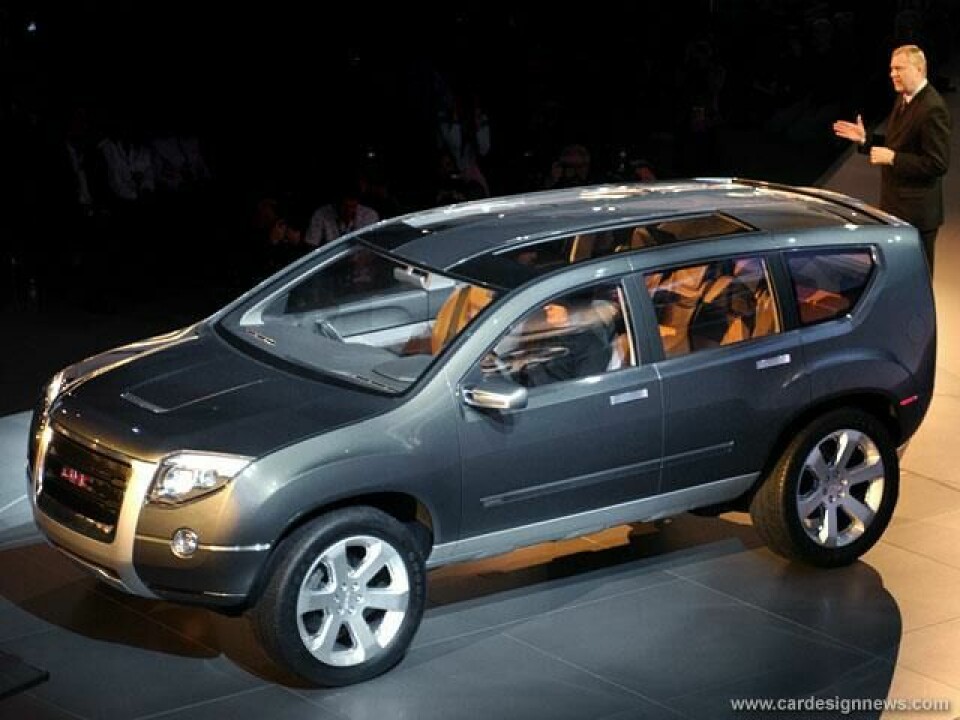
Design Review: GMC Graphyte
A design review of the GMC Graphyte
Concept cars stretch across a broad spectrum; from the light weight cappuccino froth of show cars that titillate audiences with fanciful forms only to die forever at the close of a show, to the less glamorous concept cars that are brightly coloured, large wheeled versions of the production designs they prelude. In between these poles of relative irrelevance and pretension lies the meat of modern concept car heartland: the concept car that pushes the envelope of what realistically might be in the showroom in ten years; a brand’s statement of intent. And the GMC Graphyte is just this.
Either sitting in the car or standing outside looking at it, the Graphyte is a concept car that strikes the same balance of fresh advanced design with design that we can all appreciate relative to the vehicles of today. As a statement of intent the Graphyte delivers; if it were in a GMC showroom in ten years then so too would a lot customers new to the brand. Inside it is a similar story. Designers Andrew Foster, Andrew Sheffield and lead designer Craig Sass have employed the same occasional concave surface and fluid simple surfaces between shallow angled creases of the exterior on the IP, seats, door panels and centre console. Strong, broad upper IP forms are book-ended with attractive slim vertical air vents which also flank the same height LCD screen, below which reside much of the minimalist switchgear.
Sky blue back lit prominent instrument dials stand out from what is otherwise an interior with muted colours, unusual Makanto wood veneer sparingly applied and few features that demand attention - and is all the more unique and successful for it. Like all concepts that have emerged under the direction of Simon Cox, including those similarly large SUV concepts whilst head of advanced design at Isuzu, the consistency with which design elements are interconnected and the faultless resolution of surfacing gives the Graphyte a cohesion and polish that elevates it above the sum of its parts.
But the parts are worth considering; shallow angled but crisply defined creases along the body side, over the wheel arches, on the hood, around the DLO and at the front and rear of the car are the borders for simple surfaces whose subtle fluidity is alien to most SUVs; lower line of the grille aperture picks up in a horizontal body split at the front that runs into the shallow body side moulding and then demarks the base of the innovative rear tailgate; a few concave surfaces give the car a tension and lightness of touch that balances the vehicle’s massiveness underscored by its 22inch wheels; small embossed GMC logos feature on the inside of the lamp units and door mirrors. Whilst there are some elements that have been seen before and the design is not as innovative conceptually as (say) the Skoda Roomster or Nissan Quashquai, the subtle newness of the Graphyte’s exterior design is most evident.
The exterior developed jointly by Hwasup Lee and Dale Grewer is dominated by a particularly distinctive GMC graphic (not in the early sketches shown) from a combination of the grille’s confident upper parameter line that continues outward to split the head lamp from the turn signal, and the unusually upwardly sweeping lower edges of the lamp units. This horizontally orientated graphic is echoed in miniature in the rear number plate surround and works well with the outermost brushed metal grille surround that runs vertically down and under the car to visually connect with the same treatment at the rear and side sills and effectively connect the car’s underside with the rest of its exterior.
Graphyte is a large US-orientated SUV that showcases GM’s latest petrol-electric powertrain that will be in production in two years and works in a similar way to those of the Toyota Prius and Honda Insight. This dictates that a large 300 volt battery is sited below the rear seat, but otherwise has less bearing on design parameters than the use of a separate chassis from the GMC Envoy (nee Chevrolet Trailblazer).
Whilst underpinning GMC’s “we are professional grade” rugged appeal, a separate chassis does buck the modern SUV norm and is something that typically results in a relatively crude aesthetic with wide shut lines (witness those between front bumper, grille and lamps on the Envoy), old fashioned proportions and chunky detailing - particularly where the front, rear and sides meet the underside. The design team lead by Simon Cox at GM’s advanced design studio in the UK recognised this. Along with the ambition to explore a future design direction for the GMC brand, a reaction to the typical crudity of separate chassis SUV designs became a linchpin to their brief.

GMC graphyte presentation at the 2005 Detroit Auto Show.. Click for larger images






Concept cars stretch across a broad spectrum; from the light weight cappuccino froth of show cars that titillate audiences with fanciful forms only to die forever at the close of a show, to the less glamorous concept cars that are brightly coloured, large wheeled versions of the production designs they prelude. In between these poles of relative irrelevance and pretension lies the meat of modern concept car heartland: the concept car that pushes the envelope of what realistically might be in the showroom in ten years; a brand’s statement of intent. And the GMC Graphyte is just this.

Graphyte designers Dale Grewer, Design Director Simon Cox,

2005 GMC Envoy


1:3 scale clay model




Advertisement
Advertisement
Advertisement



